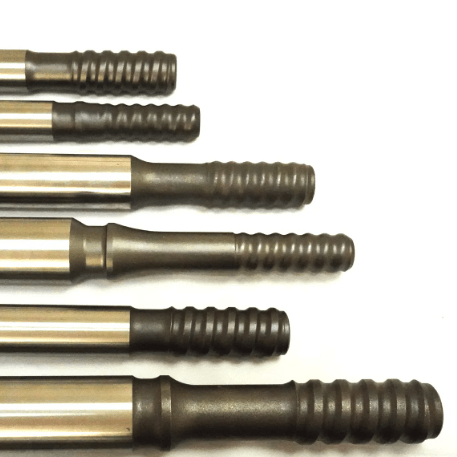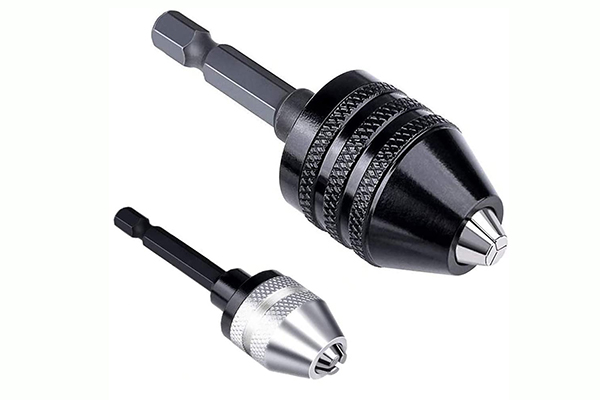In the fast-paced world of construction, mining, and geotechnical engineering, efficiency isn’t just a goal; it’s a necessity. Every minute saved on the job site translates to lower costs and faster project completion. This is where the right tools, and more specifically, the right accessories, make all the difference. The hex shank drill adapter is one such unsung hero. This small but mighty tool bridges the gap between different tool systems, unlocking a new level of versatility for your power tools. As a factory owner, I’ve spent years manufacturing and supplying these critical components, and I understand the questions and concerns that professionals like you have. This article is your comprehensive guide to understanding the hex shank drill adapter, helping you make informed purchasing decisions that boost productivity and ensure safety on site.
What Exactly is a Hex Shank Drill Adapter?
Let’s start with the basics. A hex shank drill adapter is a component that allows you to connect a tool or accessory with one type of connection (the “shank”) to a power tool that accepts a different type. The “hex shank” part specifically refers to its six-sided, hexagonal base. This is the part that fits into the chuck of your power tool, most commonly an impact driver or a modern drill with a quick-change system. Think of it as a universal translator for your toolbox.
This simple tool solves a common problem: you have the perfect drill bit for the job, but it has a round shank, and your powerful impact driver only accepts hex shanks. Instead of buying a whole new set of bits, you can use a hex shank adapter. This small piece of steel allows your impact driver to securely hold and power that round-shank drill bit. The adapter effectively converts the output of your drill, making it compatible with a much wider range of accessories, from screwdriver bits to socket wrenches and, of course, various types of drill bits.
Why is the Hex Shank Design So Popular for Drill Adapters?
The dominance of the hex shank isn’t an accident; it’s a matter of superior engineering for high-torque applications. The six flat sides of the hexagonal shank provide a much more secure grip within the tool’s chuck compared to a traditional round shank. When you’re using a powerful tool like an impact driver, the rotational force (torque) is immense. A round shank can slip under that pressure, leading to wasted energy, damage to the bit and the tool, and a frustrating lack of performance.
The hex shaft design effectively locks into the chuck, ensuring that 100% of the tool’s power is transferred directly to the bit. This is especially crucial for impact tools, which deliver rapid bursts of rotational force. The hexagonal shape prevents the bit from spinning out, providing a stable and reliable connection. This design also facilitates the quick change mechanism found on most modern impact drivers and some cordless drills. You can swap out bits and adapters in seconds, often with just one hand, dramatically speeding up your workflow on the job site.

How Do Shank Adapters Bridge the Gap Between Your Drill and Drill Bit?
A shank adapter is the ultimate problem-solver, acting as the critical link between your power source and the working end of your tool. Its primary job is to ensure compatibility. For instance, you might have a set of high-quality, heavy-duty masonry core bits with an SDS shank, but the only power tool available is a standard heavy-duty drill with a three-jaw chuck. A shank adapter makes that connection possible.
In our factory, we produce a wide variety of these adapters because we know that job sites are complex environments with tools from different generations and manufacturers. A procurement officer might need to equip multiple teams, and it’s not always cost-effective to replace every drill and bit so they all match. A high-quality Shank adapters set is a far more economical solution. It ensures that your existing inventory of valuable drill bits remains useful, regardless of the new power tools you acquire. This versatility saves money and reduces the amount of gear your team needs to carry.
Can You Use a Standard Drill Bit in an Impact Driver with an Adapter?
This is one of the most common questions we get, and the answer is a resounding yes—with the right adapter. An impact driver is designed for high-torque driving tasks, not drilling. Its quick-change collet only accepts 1/4-inch hex shanks. A standard drill bit, with its round shank, simply won’t fit. This is where the hex shank drill chuck adapter comes into play.
This brilliant little device has a hex shank on one end that snaps right into your impact driver. The other end features a traditional three-jaw chuck, just like a standard drill. You can open and close this chuck to securely grip any round-shank or hex-shank drill bit. It effectively turns your high-torque impact driver into a functional drill, perfect for situations where you need to quickly drill a pilot hole before driving a screw or a bolt. It’s an essential tool for maximizing the utility of your power tool arsenal.
What Should You Look for in a High-Quality Hex Shank Adapter Set?
As a buyer like Mark, you know that not all tools are created equal. When it comes to something that handles immense torque and vibration, quality is non-negotiable. A cheap adapter can fail under load, posing a serious safety risk and causing costly downtime. When evaluating a socket adapter set or drill bit adapter, here are the key factors to consider:
- Material: Look for adapters made from high-strength steel, such as chrome vanadium (Cr-V) or another hardened steel alloy. This ensures the tool can withstand the intense force of an impact driver without shearing or deforming. High-quality steel construction is the foundation of a reliable tool.
- Manufacturing and Certification: A reliable manufacturer will have quality control processes and often be certified under standards like ISO 9001. Ask for documentation. This is your best defense against certificate fraud, a real pain point for many international buyers. A trustworthy supplier will be transparent about their processes to ensure stability and reliability.
- Impact Rating: If you plan to use the adapter with an impact driver, ensure it is specifically “impact-rated.” We’ll cover this more in the next section, but it’s a critical distinction.
- Fit and Finish: A well-made adapter will have precise machining. The hex shank should fit snugly into the tool without wobbling, and the chuck or socket end should grip the bit securely. Poor tolerances are a sign of a low-quality tool.
| Feature | What to Look For | Why It Matters |
|---|---|---|
| Material | Chrome Vanadium (Cr-V) or Hardened Alloy Steel | Provides the strength and durability to withstand high torque and impact forces. |
| Coating | Black Oxide or Phosphate | Offers corrosion resistance, extending the life of the tool. |
| Certification | ISO 9001 or equivalent | Verifies the manufacturer has a consistent quality management system in place. |
| Fit | Precision-machined shank and chuck | Ensures a secure connection, preventing wobble, slippage, and potential accidents. |
Are All Hex Shank Drill Adapters Impact-Rated?
This is a critical safety and performance question. The answer is no. While many hex shank adapters will fit in an impact driver, only those specifically designated as “impact-rated” are designed to handle the violent, high-torque bursts these tools produce. Using a standard, non-impact-rated adapter or drill bit in an impact tool is asking for trouble.
An impact-rated adapter is constructed from more ductile steel. This means it has a slight ability to flex or “give” under the sudden rotational blows, absorbing the shock without shattering. A standard adapter, made from more brittle steel, is likely to crack or break apart when subjected to that force. A shattered piece of metal flying off a tool rotating at high speed is a significant safety hazard. Always check the product specifications and packaging for an explicit “impact-rated” designation before using an adapter with an impact driver. For any professional, prioritizing safety and using the correct tool for the job is paramount.

What are the Different Types of Drill Adapters Available?
The world of drill adapters is diverse, with specialized tools designed for various tasks. Understanding the different types helps you build a more versatile and efficient toolkit. Besides the common hexagonal shank drill adapter, which converts a standard drill bit for use in an impact driver, here are a few other essential types:
- Hex Shank Socket Adapter: This type has a hex shank on one end and a square drive (typically 1/4”, 3/8”, or 1/2”) on the other. It allows your drill or impact driver to function as a power ratchet, driving sockets to tighten or loosen nuts and bolts. A good socket adapter set is a must-have for mechanics and assembly workers.
- Right-Angle Attachment: This adapter allows you to drill or drive in tight spaces where a standard drill won’t fit. It changes the angle of rotation by 90 degrees, making it invaluable for cabinet installation, automotive repair, or working between studs.
- Keyless Chuck Adapter: This is another name for the hex shank drill chuck adapter we discussed earlier. Its key feature is the “keyless” design, which allows you to tighten or loosen the chuck by hand, making bit changes fast and simple.
- Extension Adapters: These are essentially rigid extension bars with a hex shank on one end and a female hex receiver on the other. They allow you to reach screws or drill holes in deep, inaccessible areas.
Each drill adapter serves a unique purpose, and having a comprehensive drill bit set that includes these various adapters ensures you’re prepared for any challenge the job site throws at you. For a look at the types of bits these adapters connect to, you can explore our range of Rock Drilling Bits.
How Does a Hex Shank Drill Chuck Adapter Work?
The mechanics of a hex shank drill chuck adapter are quite simple but ingenious. Let’s break it down into a few easy steps for someone who is more focused on the business side than the technical details.
- Insertion: The solid, 1/4-inch hex shank end of the adapter is inserted into the quick-change collet of your impact driver. It clicks into place just like any other screwdriver bit.
- Gripping the Bit: The other end of the adapter is a miniature version of a standard drill chuck. By twisting the outer sleeve, you cause three internal jaws to either move inward or outward. You twist it open, insert the round shank of your drill bit, and then twist the sleeve in the opposite direction to tighten the jaws securely around the bit.
- Power Transfer: When you pull the trigger on your impact driver, the tool rotates the adapter’s hex shank. Because the adapter is a single, solid piece of metal, this rotation is transferred directly to the chuck, which in turn spins the drill bit. It effectively makes your impact driver operate like a standard drill.
This straightforward mechanism is what makes this tool so incredibly useful. It adds a whole new dimension of functionality to your most powerful driving tool without needing a complicated setup.
What are the Common Mistakes to Avoid When Choosing a Hex Shank Adapter?
Making the right purchasing decision is crucial for profitability and project success. Over the years, I’ve seen clients make a few common mistakes that lead to frustration and wasted money. As someone who procures equipment, avoiding these pitfalls will save you headaches down the line.
The first mistake is prioritizing price over quality. A surprisingly cheap adapter or drill bit set from an unknown source is often a red flag. These are likely made from inferior metal that will fail quickly, especially under the stress of an impact tool. The cost of downtime and replacing a broken tool far outweighs the initial savings. Secondly, be wary of suppliers who cannot provide clear documentation or certifications. As mentioned, certificate fraud is a real issue. A reputable factory will have no problem sharing its quality control data and ISO certificates.
Another common error is buying the wrong tool for the application. Using a non-impact adapter in an impact driver is a classic example. It’s not just inefficient; it’s dangerous. Finally, don’t overlook logistics and communication. Working with a supplier who is slow to respond or unclear about shipping times can lead to project delays—a major pain point for any contractor. A good partner communicates proactively and helps you navigate the complexities of international shipping. This is especially true when purchasing complete systems, like a Self-drilling Hollow Anchor system, where every component must arrive on time.
Finding a Reliable Supplier for Your Shank Adapters and Drilling Tools
For a procurement officer like Mark, the supplier relationship is just as important as the product itself. Finding a partner you can trust is key to running a smooth and profitable operation. You need a supplier who understands your business, communicates clearly, and delivers a consistently high-quality product on time. This is where working directly with a factory like ours can be a significant advantage.
When you search for suppliers, whether on Google or at exhibitions, look beyond the price list. Ask about their production capacity—we run seven production lines to ensure we can meet large orders without delay. Inquire about their quality control procedures and ask to see their certifications. Discuss logistics and payment terms upfront to ensure there are no surprises. A reliable partner will be an open book. We pride ourselves on building long-term relationships based on trust, not just transactions. We understand that when you succeed, we succeed. We provide not just a tool, but a complete support system for your procurement needs.
Key Takeaways
Choosing the right hex shank drill adapter and supplier is a critical business decision. Here are the most important things to remember:
- Function First: The hex shank adapter is a versatile tool that unlocks the full potential of your impact drivers and drills by allowing them to use a wider range of bits and accessories.
- Hex Means Grip: The hexagonal design is superior for high-torque applications, preventing slippage and ensuring maximum power transfer.
- Quality is Non-Negotiable: Always choose adapters made from high-strength, hardened steel alloys like chrome vanadium to ensure stability and durability.
- Safety with Impact: Only use adapters specifically marked as “impact-rated” with impact drivers to prevent catastrophic failure and ensure operator safety.
- Vet Your Supplier: Look for a manufacturing partner with verifiable certifications (like ISO 9001), transparent communication, and a proven track record to avoid logistical delays and quality issues.
- Versatility is Key: A good set of adapters, including chuck adapters and socket adapters, can save significant money by allowing you to use your existing bits with new tools.
Post time: Aug-25-2025
















